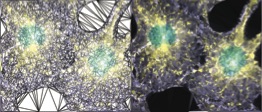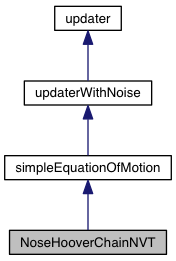 |
CellGPU
0.8.0
GPU-accelerated simulations of cells
|
 |
CellGPU
0.8.0
GPU-accelerated simulations of cells
|
Implements NVT dynamics according to the Nose-Hoover equations of motion with a chain of thermostats. More...
#include <NoseHooverChainNVT.h>

Public Member Functions | |
| NoseHooverChainNVT (int N, int M=2) | |
| The base constructor asks for the number of particles and the length of the chain. More... | |
| virtual void | set2DModel (shared_ptr< Simple2DModel > _model) |
| set the internal State to the given model | |
| virtual void | integrateEquationsOfMotion () |
| the fundamental function that models will call, using vectors of different data structures More... | |
| virtual void | integrateEquationsOfMotionCPU () |
| call the CPU routine to integrate the e.o.m. More... | |
| virtual void | integrateEquationsOfMotionGPU () |
| call the GPU routine to integrate the e.o.m. More... | |
| Dscalar | getT () |
| Get temperature, T. | |
| void | setT (Dscalar _T) |
| Set temperature, T, and also the bath masses! More... | |
| void | reportBathData () |
| Report the current status of the bath. More... | |
| int | getTimestep () |
| get the number of timesteps run | |
| Dscalar | getTime () |
| get the current simulation time | |
| virtual void | setDeltaT (Dscalar dt) |
| Set the simulation time stepsize. | |
| virtual void | performUpdate () |
| performUpdate just maps to integrateEquationsOfMotion | |
| virtual void | setReproducible (bool rep) |
| Set whether the source of noise should always use the same random numbers. | |
| void | reIndexRNG (GPUArray< curandState > &array) |
| re-index the any RNGs associated with the e.o.m. | |
| virtual void | Update (int timestep) |
| The fundamental function that a controlling Simulation can call. | |
| void | setPeriod (int _p) |
| set the period | |
| void | setPhase (int _p) |
| set the phase | |
| virtual void | spatialSorting () |
| allow for spatial sorting to be called if necessary... | |
| virtual void | setGPU () |
| Enforce GPU-only operation. This is the default mode, so this method need not be called most of the time. | |
| virtual void | setCPU () |
| Enforce CPU-only operation. Derived classes might have to do more work when the CPU mode is invoked. | |
| int | getNdof () |
| Get the number of degrees of freedom of the equation of motion. | |
| void | setNdof (int _n) |
| Set the number of degrees of freedom of the equation of motion. | |
Public Attributes | |
| shared_ptr< Simple2DModel > | State |
| The system that can compute forces, move degrees of freedom, etc. | |
| GPUArray< Dscalar > | kineticEnergyScaleFactor |
| Helper structure for GPU branch. A two-component GPU array that contains the total KE and the velocity scale factor. | |
| GPUArray< Dscalar4 > | BathVariables |
| the (position,velocity,acceleration,mass) of the bath degrees of freedom | |
| shared_ptr< Simple2DModel > | model |
| A pointer to a Simple2DModel that the updater acts on. | |
Protected Member Functions | |
| void | propagateChain () |
| Propagate the chain. More... | |
| void | propagatePositionsVelocities () |
| Propagate the position and velocity of the particles. More... | |
| void | rescaleVelocitiesGPU () |
| Rescale velocities on the GPU. More... | |
| void | calculateKineticEnergyGPU () |
| combine kernel calls for vector combination and parallel reduction to compute the KE in the helper structure More... | |
| void | propagatePositionsVelocitiesGPU () |
| Propagate the position and velocity of the particles...on the gpu. More... | |
| void | reIndexArray (GPUArray< int > &array) |
| Re-index cell arrays after a spatial sorting has occured. | |
| void | reIndexArray (GPUArray< Dscalar > &array) |
| why use templates when you can type more? | |
| void | reIndexArray (GPUArray< Dscalar2 > &array) |
| why use templates when you can type more? | |
Protected Attributes | |
| Dscalar | Temperature |
| The targeted temperature. | |
| int | Nchain |
| The length of the NH chain. | |
| int | Ndof |
| The number of particles in the State. | |
| GPUArray< Dscalar > | keArray |
| A helper vector for the GPU branch...can be asked to store 0.5*m[i]*v[i]^2 as an array. | |
| GPUArray< Dscalar > | keIntermediateReduction |
| A helper structure for performing parallel reduction of the keArray. | |
| int | Timestep |
| Count the number of integration timesteps. | |
| Dscalar | deltaT |
| The time stepsize of the simulation. | |
| GPUArray< Dscalar2 > | displacements |
| an internal GPUArray for holding displacements | |
| noiseSource | noise |
| A source of noise for the equation of motion. | |
| int | Period |
| The period of the updater... the updater will work every Period timesteps. | |
| int | Phase |
| The phase of the updater... the updater will work every Period timesteps offset by a phase. | |
| bool | GPUcompute |
| whether the updater does its work on the GPU or not | |
| vector< int > | reIndexing |
| a vector of the re-indexing information | |
Implements NVT dynamics according to the Nose-Hoover equations of motion with a chain of thermostats.
This allows one to do standard NVT simulations. A chain (whose length can be specified by the user) of thermostats is used to maintain the target temperature. We closely follow the Frenkel & Smit update scheme, which is itself based on: Martyna, Tuckerman, Tobias, and Klein Mol. Phys. 87, 1117 (1996)
| NoseHooverChainNVT::NoseHooverChainNVT | ( | int | N, |
| int | M = 2 |
||
| ) |
The base constructor asks for the number of particles and the length of the chain.
Initialize everything, by default setting the target temperature to unity. Note that in the current set up the thermostate masses are automatically set by the target temperature, assuming = 1
References BathVariables, ArrayHandle< T >::data, simpleEquationOfMotion::deltaT, simpleEquationOfMotion::displacements, updater::GPUcompute, keArray, keIntermediateReduction, kineticEnergyScaleFactor, Nchain, Ndof, GPUArray< T >::resize(), setT(), and simpleEquationOfMotion::Timestep.
|
virtual |
the fundamental function that models will call, using vectors of different data structures
Advance by one time step. Of note, for computational efficiency the topology is only updated on the half-time steps (i.e., right before the instantaneous forces will to be computed). This means that after each call to the simulation to "performTimestep()" there is no guarantee that the topology will actually be up-to-date. Probably best to call enforceTopology just before saving or evaluating shape outside of the normal timestep loops.
Reimplemented from simpleEquationOfMotion.
References simpleEquationOfMotion::displacements, updater::GPUcompute, integrateEquationsOfMotionCPU(), integrateEquationsOfMotionGPU(), Ndof, GPUArray< T >::resize(), setT(), State, Temperature, and simpleEquationOfMotion::Timestep.
Referenced by set2DModel().
|
virtual |
call the CPU routine to integrate the e.o.m.
The implementation here closely follows algorithms 30 - 32 in Frenkel & Smit, generalized to the case where the chain length is not necessarily always 2
References ArrayHandle< T >::data, access_location::host, kineticEnergyScaleFactor, Ndof, propagateChain(), propagatePositionsVelocities(), access_mode::read, and State.
Referenced by integrateEquationsOfMotion(), and set2DModel().
|
virtual |
call the GPU routine to integrate the e.o.m.
The GPU implementation of the identical algorithm done on the CPU
References calculateKineticEnergyGPU(), propagateChain(), propagatePositionsVelocitiesGPU(), and rescaleVelocitiesGPU().
Referenced by integrateEquationsOfMotion(), and set2DModel().
| void NoseHooverChainNVT::setT | ( | Dscalar | T | ) |
Set temperature, T, and also the bath masses!
Set the target temperature to the specified value. Additionally, use the observation in the Mol Phys paper to set the masses of the chain of thermostats
Referenced by integrateEquationsOfMotion(), and NoseHooverChainNVT().
| void NoseHooverChainNVT::reportBathData | ( | ) |
Report the current status of the bath.
print out the current state of the bath: (pos, vel, accel, mass) for each element of the chain
References BathVariables, ArrayHandle< T >::data, and GPUArray< T >::getNumElements().
|
protected |
Propagate the chain.
The simple part of the algorithm partially updates the chain positions and velocities. It should be called twice per time step
References kineticEnergyScaleFactor.
Referenced by integrateEquationsOfMotionCPU(), and integrateEquationsOfMotionGPU().
|
protected |
Propagate the position and velocity of the particles.
The simple part of the algorithm actually updates the positions and velocities of the partices. This is the step in which a force calculation is required.
References ArrayHandle< T >::data, and kineticEnergyScaleFactor.
Referenced by integrateEquationsOfMotionCPU().
|
protected |
Rescale velocities on the GPU.
Simply call the velocity rescaling function...
References ArrayHandle< T >::data, access_location::device, gpu_NoseHooverChainNVT_scale_velocities(), kineticEnergyScaleFactor, Ndof, access_mode::read, access_mode::readwrite, and State.
Referenced by integrateEquationsOfMotionGPU().
|
protected |
combine kernel calls for vector combination and parallel reduction to compute the KE in the helper structure
This combines multiple kernel calls. First we make a vector of kinetic energies per particle, then we perform a parallel block reduction, and then a serial reduction
References ArrayHandle< T >::data, access_location::device, gpu_parallel_reduction(), gpu_prepare_KE_vector(), keArray, keIntermediateReduction, kineticEnergyScaleFactor, Ndof, access_mode::overwrite, access_mode::read, access_mode::readwrite, and State.
Referenced by integrateEquationsOfMotionGPU().
|
protected |
Propagate the position and velocity of the particles...on the gpu.
Do a multi-step dance to get the positions and velocities updated on the gpu branch
Referenced by integrateEquationsOfMotionGPU().
 1.8.13
1.8.13